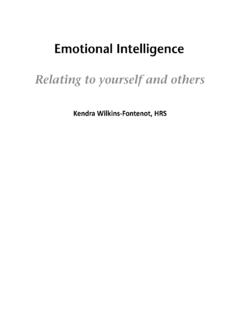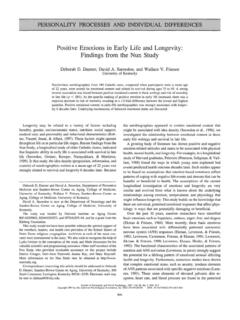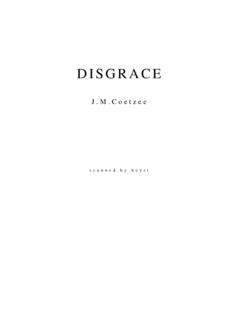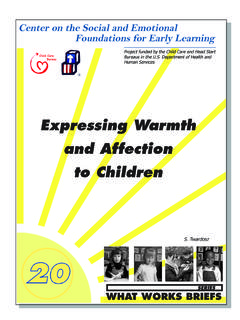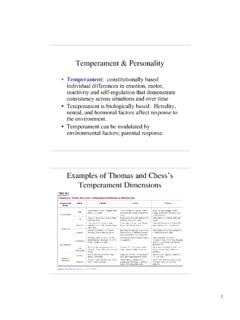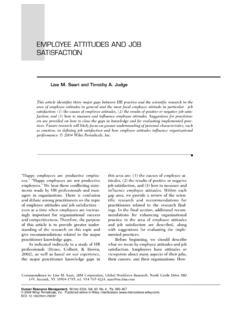Transcription of Emotions that facilitate language learning: The positive ...
1 Studies in Second language Learning and Teaching Department of English Studies, Faculty of Pedagogy and Fine Arts, Adam Mickiewicz University, Kalisz SSLLT 2 (2). 193-213. Emotions that facilitate language learning: The positive -broadening power of the imagination1. Peter MacIntyre Cape Breton University, Sydney, Nova Scotia, Canada Tammy Gregersen University of Northern Iowa, Cedar Falls, USA. Abstract The imagination is powerful, in part, because of the Emotions that can be activated by imagining future states. Imagined future states are a key fea- ture of the L2 self-system proposed by D rnyei, and emotion may be the key to the motivational quality of the imagined future self. In particular, this pa- per focuses on positive anticipated and anticipatory Emotions related to language learning. It is argued that, in general, positive emotion has a dif- ferent function from negative emotion; they are not opposite ends of the same spectrum.
2 Based on the work of Fredrickson, we argue that positive emotion facilitates the building of resources because positive emotion tends to broaden a person's perspective, opening the individual to absorb the lan- guage. In contrast, negative emotion produces the opposite tendency, a nar- rowing of focus and a restriction of the range of potential language input. This article draws a framework for finding a balance between the positive - broadening and negative-narrowing Emotions in the language classroom, 1. Authors' note: This research was facilitated by a grant from Cape Breton University. We would like to thank Jillian Burns for comments on an earlier draft of the manuscript. Corre- spondence may be sent to: Tammy Gregersen, University of Northern Iowa, Department of Languages and Literatures, Cedar Falls, IA, 50613, USA or 193.
3 Peter MacIntyre, Tammy Gregersen and beyond. The emotion system is an engine for the positive -broadening power of the imagination. Keywords: imagination, motivation, self, Emotions , positive -broadening Imagine there's no heaven, it's easy if you try John Lennon Imagination is powerful. Songwriters, poets, politicians, and motivation- al speakers draw upon the potency of imagination to reveal truths about the present and propel us toward their version of the future. Imagination works best when it activates emotion; the poets have known this all along. As lan- guage teachers, learners and researchers we have yet to fully appreciate the value of imagination and the power of emotion in our accounts of the learning process. Our goal in this paper is to establish a theoretical foundation on which to build a more complete understanding of the ways in which affect and imagination contribute to language learning.
4 After laying out our conceptual foundation by characterizing Emotions through a variety of defining features, we attempt to demonstrate how teachers can create classroom and task con- ditions that draw upon the power of their learners' imaginations to both pro- voke essential reactions and optimize the cognition that modifies learners'. emotional schemas. When learners feel the burden of negative-narrowing emotion, it is our goal to help teachers find ways to transform it into positive - broadening, empowering resources. Characterizing Emotion Defining a concept like emotion is not an especially easy task. Common usage seems to arrive at a circular definition where Emotions are defined as feelings and feelings are defined as emotional states. Johnmarshall Reeve (2005, p. 294) offers a good discussion of emotion and its definitional issues.
5 Reeve settles on a multidimensional definition: Emotions are short-lived, feeling- arousal-purposive-expressive phenomena that help us adapt to the opportuni- ties and challenges we face during important life events. The feeling compo- nent reflects the subjective experience we so often equate with emotion. The second component, arousal, has been the topic of considerable research, suc- cessfully finding unique patterns of physical responses that accompany certain specific Emotions , as when heart rate and blood pressure increase during anxie- ty. The third component is purposive, reflecting the goal-directedness of emo- 194. Emotions that facilitate language learning: The positive -broadening power of the imagination tion. Finally, the expressive component gives emotion its social and communica- tive dimension; for example, involuntary (unlearned) facial expressions are as- sociated with universal Emotions and tend to be easy to read.
6 But Emotions must be understood to be more than the sum of these parts. An emotion is emergent from the coordination of these four aspects of experience. Anxiety is perhaps the most studied emotion in second language acquisi- tion (MacIntyre & Gregersen, 2012). Consistent with Reeve's definition, lan- guage anxiety can be understood as an emergent, coordinated emotion with feeling, arousal, purposive and expressive phenomena. The feelings associated with language anxiety, well described in qualitative research, include tension, nervousness, worry, dread, upset, and similar terms. The physical dimension also is present the heart races, the body sweats, the hands tremble, and there is a sinking feeling in the stomach (Reeve, 2005). This is a coordinated reaction governed by the interaction of the sympathetic and parasympathetic nervous systems, often called the fight-or-flight response.
7 The purpose of a fight-or-flight response in language learning might not be readily apparent, but can be found just below the surface. The feelings associated with language anxiety typically precede avoidance or escape; we want to leave a situation that makes us anxious as a means of self-protection. We are at risk in a situa- tion where we cannot understand what is being said. If we do not understand the people around us, we are subjected to a primitive question: How can we fit into, and avoid being rejected by this group? The expression of language anxiety is a voluntary and/or involuntary call for help, a cue to the other peo- ple in the situation that the anxious learner is or might be in distress. A long standing question in emotion research has focused on the number of Emotions . In response to this line of enquiry, a small number of discrete, core, basic Emotions have been identified cross-culturally.
8 Paul Ekman's (1972). work on facial recognition has shown that facial displays of basic Emotions can be correctly interpreted across cultures. Robert Pluchick (2011) emphasizes an evolutionary perspective to identify Emotions that are foundational, common across species and divisions within a species ( , cultures). According to Reeve (2005), the list of Emotions generated by this approach has featured mostly negative Emotions (fear, anger, disgust, sadness) with one or two positive emo- tions (joy, interest). Perhaps the appeal of seeking to identify the basic Emotions is that the number has been rather small, between three and eleven different Emotions , depending on how the classification is developed. An alternative to the search for basic Emotions is a search for emotion words in the lexicon. A lexical-cognitive perspective emphasizes the role of social, contextual and attribution processes in defining the many shades of emotional experience.
9 A woman might love learning French, but that is not the 195. Peter MacIntyre, Tammy Gregersen same love she has for her father, her mother, her eldest daughter, the cat, playing bridge, and eating chocolate. Some core emotion in these cases (love, affection, care) might be similar but the shades of interpretation and meaning are very different and integral to the experience of each type of love. Dewaele (2010) emphasizes this dimension of emotion when he discusses the difficul- ties learners encounter in expressing Emotions across languages. Pavlenko (2002) also discusses how bilinguals' conversation about emotion evolves through the process of second language socialization as evidenced by exam- ples of second language influence on first language performance. Caroll Izard's (2011) recent work on differential Emotions has offered a valuable distinction between basic or first-order Emotions and more com- plex emotion schemas.
10 First-order Emotions require only the minimal cognitive processes of perceiving and imaging in order to trigger a rapid and sometimes automatic action. These process- es may often occur without reportable awareness, particularly in early develop- ment. In contrast, emotion schemas always involve interactions among emotion feelings and higher order cognition thoughts, strategies, and goals that comple- ment and guide responding to the emotion experience. (p. 372). Izard (2011) identified the first-order Emotions as interest, enjoy- ment/happiness/contentment, sadness, anger, disgust, fear, and possibly con- tempt. Higher-order emotion schemas can be simple or complex combinations of Emotions , mixed with cognitive and self-regulation elements, that allow for interpretation and continual interaction with the surrounding context.










